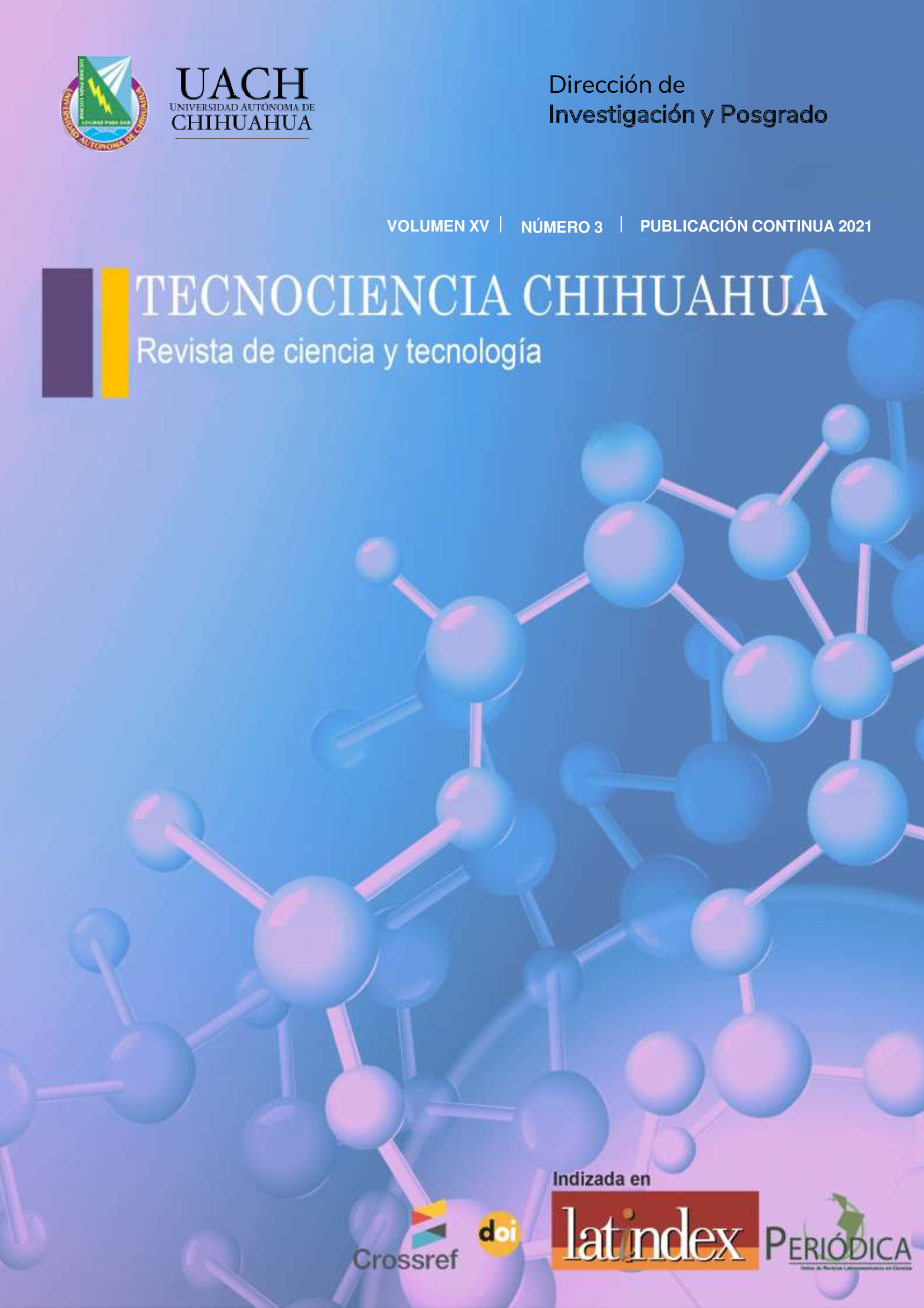Almidón de camote: Modificaciones enzimáticas, físicas y químicas
Sweet potato starch: Enzymatic, physical and chemical modifications: A review
DOI:
https://doi.org/10.54167/tecnociencia.v15i3.854Palabras clave:
hidrólisis, gelatinización, propiedades funcionales, amilosa, microestructuraResumen
El almidón es el principal carbohidrato de reserva en productos vegetales y es ampliamente utilizado en la industria alimentaria. El camote es una fuente importante de almidón, ya que forma parte de su composición química en el rango de 50 - 80%. Sin embargo, en su forma nativa carece de propiedades que lo conviertan es un material ideal con potencial para aplicaciones en productos alimenticios. Por esto, con la finalidad de subsanar tal desventaja se recurre a procesos de modificación que permitan cambiar sus propiedades fisicoquímicas como la cristalinidad, viscosidad, tamaño de gránulo, temperatura de gelatinización, retrogradación, solubilidad, poder de hinchamiento, etc. Las modificaciones del almidón se centran en tres tipos de métodos; los enzimáticos (altamente eficientes), los físicos (diversos y económicos) y los químicos (selectivos). Cada vez resulta de mayor interés probar métodos de modificación en nuevas fuentes de almidón y debido a la alta producción de camote a nivel mundial, es importante mostrar los contrastes de los diferentes métodos utilizados. Por lo tanto, el objetivo de esta revisión es mostrar los estudios realizados para la modificación de almidón de camote y su efecto sobre las propiedades fisicoquímicas.
Descargas
Citas
Abegunde, O. K., Mu, T., Chen, J., & Deng, F. (2013). Food Hydrocolloids Physicochemical characterization of sweet potato starches popularly used in Chinese starch industry. Food Hydrocolloids, 33(2), 169–177. https://doi.org/10.1016/j.foodhyd.2013.03.005
Aina, A. J., Falade, K. O., Akingbala, J. O., Titus, P., & Titus, P. (2012). Physicochemical Properties of Caribbean Sweet Potato ( Ipomoea batatas ( L ) Lam ) Starches. Food Bioprocess Technol, 5, 576–583. https://doi.org/10.1007/s11947-009-0316-6
Akin-Ajani, O. D., Itiola, O. A., & Odeku, O. A. (2016). Evaluation of the disintegrant properties of native and modified forms of fonio and sweet potato starches. Starch, 68, 169–174. https://doi.org/10.1002/star.201500188
Altuna, L., Herrera, M.L., & Foresti, M.L. (2018). Food Hydrocolloids Synthesis and characterization of octenyl succinic anhydride modified starches for food applications . A review of recent literature. Food Hydrocolloids, 80, 97–110. https://doi.org/10.1016/j.foodhyd.2018.01.032
Bemiller, J. N., & Huber, K. C. (2015). Physical modification of food starch functionalities. Annual Review of Food Science and Technology, 6, 19–69. https://doi.org/10.1146/annurev-food-022814-015552
FAOSTAT. (2020). Sweet potato. Retrieved on August 10, 2020, from FAO Website: www.fao.org/faostat/ en/#data/QC
Chen, Z., Schols, H.A., & Voragen, A.G.J. (2003). Physicochemical Properties of Starches Obtained from Three Varieties of Chinese Sweet Potatoes. Food Chemistry and Toxicology Physicochemical, 68(2), 431–437. http://dx.doi.org/10.1111/j.1365-2621.2003.tb05690.x
Guo, L. (2018). Sweet potato starch modifed by branching enzyme, β-amylase and transglucosidase. Food Hydrocolloids, 83, 182–189. https://doi.org/10.1016/j.foodhyd.2018.05.005
Guo, L., Li, H., Zhu, Y., & Cui, B. (2019). The structure property and adsorption capacity of new enzyme-treated potato and sweet potato starches. International Journal of Biological Macromolecules, 1(144), 863–873. https://doi.org/10.1016/j.ijbiomac.2019.09.164
Guo, L., Tao, H., Cui, B., & Janaswamy, S. (2019). The effects of sequential enzyme modifications on structural and physicochemical properties of sweet potato starch granules. Food Chemistry, 277, 504–514. https://doi.org/10.1016/j.foodchem.2018.11.014
Guo, J., Tang, W., Quek, S. Y., Liu, Z., & Lu, S. (2020). Evaluation of structural and physicochemical properties of octenyl succinic anhydride modified sweet potato starch with different degrees of substitution. Journal of Food Science, 85, 666–672. https://doi.org/10.1111/1750-3841.15031
Hizukuri, S. (1985). Relationship between length of the chain length of amylopectin and the crystalline structure of starch granules. Carbohydrate Research, 141, 141, 295–306. https://doi.org/10.1016/S0008-6215(00)90461-0
Huang, T., Zhou, D., Jin, Z., Xu, X., & Chen, H. (2016). Food Hydrocolloids Effect of repeated heat-moisture treatments on digestibility , physicochemical and structural properties of sweet potato starch. Food Hydrocolloids, 54, 202–210. https://doi.org/10.1016/j.foodhyd.2015.10.002
Issa, A. T., Schimmel, K. A., Worku, M., Shahbazi, A., Ibrahim, S. A., & Tahergorabi, R. (2018). Sweet Potato Starch-Based Nanocomposites: Development, Characterization, and Biodegradability. Starch, 70, 1700273. https://doi.org/10.1002/star.201700273
Kwon, C., Kim, H. R., Moon, T. W., Lee, S. H., & Lee, C. J. (2019). Structural and Physicochemical Characteristics of Granular Malic Acid-Treated Sweet Potato Starch Containing Heat-Stable Resistant Starch. Journal of Chemistry, 1–11. https://doi.org/10.1155/2019/2903252
Li, W., Li, C., Gu, Z., Qiu, Y., Cheng, L., & Hong, Y. (2016). Relationship between structure and retrogradation properties of corn starch treated with 1,4- α -glucan branching enzyme. Food Hydrocolloids, 52, 868–875. https://doi.org/10.1016/j.foodhyd.2015.09.009
Li, Y., Liu, S., Liu, X., Tang, X., & Zhang, J. (2017). The Impact of Heat-Moisture Treatment on Physicochemical Properties and Retrogradation Behavior of Sweet Potato Starch. International Journal OfFood Engineering, 20170001. https://doi.org/10.1515/ijfe-2017-0001
Li, N., Cai, Z., Guo, Y., Xu, T., Qiao, D., Zhang, B., Zhao, S., Huang, Q., Niu, M., Jia, C., Lin, L., & Lin, Q. (2019). Hierarchical structure and slowly digestible features of rice starch following microwave cooking with storage. Food Chemistry, 295, 475–483. https://doi.org/10.1016/j.foodchem.2019.05.151
Liao, L., Liu, H., Gan, Z., & Wu, W. (2019). Structural properties of sweet potato starch and its vermicelli quality as affected by heat-moisture treatment. International Journal of Food Properties, 22(1), 1122–1133. https://doi.org/10.1080/10942912.2019.1626418
Liu, Y., Chen, J., Luo, S., Li, C., Ye, J., Liu, C., & Gilbert, R. G. (2017). Physicochemical and structural properties of pregelatinized starch prepared by improved extrusion cooking technology. Carbohydrate Polymers, 175, 265–272. https://doi.org/10.1016/j.carbpol.2017.07.084
Lv, Q., Li, G., Xie, Q., Zhang, B., Li, X., Pan, Y., & Chen, H. (2018). Evaluation studies on the combined effect of hydrothermal treatment and octenyl succinylation on the physic-chemical, structural and digestibility characteristics of sweet potato starch. Food Chemistry, 256, 413–418. https://doi.org/10.1016/j.foodchem.2018.02.147
Martínez, P., Peña, F., Bello-Pérez, L.A., Nuñez-Santiago, C., Yee-Madeira, H., & Velezmoro, C. (2019). Physicochemical, functional and morphological characterization of starches isolated from three native potatoes of the Andean region. Food Chemistry: X, X 2 (2019) 100030. https://doi.org/10.1016/j.fochx.2019.100030
Minh, N. P. (2021). Peracetic acid concentration and starch slurry ratio on functional properties of oxidized sweet potato (Ipomoea batatas (L.) Lam.) starch. Plant Science Today, 8(1), 112–117. http://dx.doi.org/10.14719/pst.2021.8.1.957
Mu, T., Sun, H. S., Zhang, M., & Wang, C. (2017). Sweet Potato Starch and its Series Products. In Sweet Potato Processing Technology (pp. 7–9). http://dx.doi.org/10.1016/B978-0-12-812871-8.00001-5
Mu, T. & Jaspreet, S. (2019). Sweet potato: chemistry, processing, and nutrition—an introduction. In Sweet Potato: Chemistry, Processing, and Nutrition (pp. 1–2).
Na, J. H., Kim, H. R., Kim, Y., Lee, J. S., Park, H. J., Moon, T. W., & Lee, C. J. (2020). Structural characteristics of low-digestible sweet potato starch prepared by heat-moisture treatment. International Journal of Biological Macromolecules, 151, 1049–1057. https://doi.org/10.1016/j.ijbiomac.2019.10.146
Naguleswaran, S., Vasanthan, T., Hoover, R., & Bressler, D. (2014). Food Hydrocolloids Amylolysis of amylopectin and amylose isolated from wheat , triticale , corn and barley starches. Food Hydrocolloids, 35, 686–693. https://doi.org/10.1016/j.foodhyd.2013.08.018
Rahman, M. H., Mu, T. H., Zhang, M., Ma, M. M., & Sun, H. N. (2020). Comparative study of the effects of high hydrostatic pressure on physicochemical, thermal, and structural properties of maize, potato, and sweet potato starches. Journal of Food Processing and Preservation, 44(11), 1–11. https://doi.org/10.1111/jfpp.14852
Remya, R., Jyothi, A. N., & Sreekumar, J. (2018). Morphological, structural and digestibility properties of RS4 enriched octenyl succinylated sweet potato, banana and lentil starches. Food Hydrocolloids, 82, 219–229. https://doi.org/10.1016/j.foodhyd.2018.04.009
Rodrigues, T. P., Landi, C. M., do Carmo, E., Jane, J. lin, & Leonel, M. (2019). Effect of spray-drying and extrusion on physicochemical characteristics of sweet potato starch. Journal of Food Science and Technology, 56(1), 376–383. https://doi.org/10.1007/s13197-018-3498-y
Shariffa, Y. N., Uthumporn, U., Karim, A. A., & Zaibunnisa, A. H. (2017). Hydrolysis of native and annealed tapioca and sweet potato starches at sub- gelatinization temperature using a mixture of amylolytic enzymes. International Food Research Journal, 24(5), 1925–1933. http://ifrj.upm.edu.my/24%20(05)%202017/(12).pdf
Singh, N., & Kaur, L. (2004). Morphological , thermal , rheological and retrogradation properties of potato starch. Journal of the Science of Food and Agriculture, 84, 1241–1252. https://doi.org/10.1002/jsfa.1746
Soltovski, C., Camila, D. O., Bet, D., Zabian, R., Bisinella, B., Henrique, L., Colman, D., & Schnitzler, E. (2018). Heat-moisture treatment (HMT) on blends from potato starch (PS) and sweet potato starch (SPS). Journal of Thermal Analysis and Calorimetry, 133, 1491–1498. https://doi.org/10.1007/s10973-018-7196-9
Thanh, P., Trung, B., Bui, L., Ngoc, B., Hoa, P. N., Ngoc, N., Tien, T., & Hung, P. Van. (2017). Impact of Heat-moisture and Annealing Treatments on Physicochemical Properties and Digestibility of Starches from Different Colored Sweet Potato Varieties. International Journal of Biological Macromolecules, 105, 1071–1078. https://doi.org/10.1016/j.ijbiomac.2017.07.131
Trancoso-Reyes, N., Ochoa-Martínez, L. A., Bello-Pérez, L. A., Morales-Castro, J., Estévez-Santiago, R., & Olmedilla-Alonso, B. (2016). Effect of pre-treatment on physicochemical and structural properties, and the bioaccessibility of β-carotene in sweet potato flour. Food Chemistry, 200, 199–205. https://doi.org/10.1016/j.foodchem.2016.01.047
Ulfa, G. M., Putri, W. D. R., Fibrianto, K., & Widjanaarko, S. B. (2021). Optimization studies on pre-gelatinized sweet potato starch influenced by temperature and time. Food Research, 5(2), 25–30 https://doi.org/10.26656/fr.2017.5(S2).017
Vermeylen, R., Goderis, B., Reynaers, H., & Delcour, J. A. (2004). Amylopectin molecular structure reflected in macromolecular organization of granular starch. Biomacromolecules, 5, 1775–1786. https://doi.org/10.1021/bm0499132
Wang, H., Liu, Y., Chen, L., Li, X., Wang, J., & Xie, F. (2018). Insights into the multi-scale structure and digestibility of heat-moisture treated rice starch. Food Chemistry, 242, 323–329. https://doi.org/10.1016/j.foodchem.2017.09.014
Wang, H., Xu, K., Liang, Y., Zhang, H., Chen, L., Xu, K., Liang, Y., Zhang, H., & Chen, L. (2020). Impact of ultrasonication on the aggregation structure and physicochemical characteristics of sweet potato starch. Ultrasonics Sonochemistry, 63(104868). https://doi.org/10.1016/j.ultsonch.2019.104868
Wang, X., Hu, A., Zheng, J., Li, L., Li, L., & Li, Y. (2020). Physicochemical properties and structure of annealed sweet potato starch: effects of enzyme and ultrasound. Starch, 72, 1900247. https://doi.org/10.1002/star.201900247
Zhang, B., Wu, H., Gou, M., Xu, M., Liu, Y., Jing, L., Zhao, K., & Jiang, H. (2019). The Comparison of Structural , Physicochemical , and Digestibility Properties of Repeatedly and Continuously Annealed Sweet Potato Starch. Journal of Food Science, 0(0), 1–9. https://doi.org/10.1111/1750-3841.14711
Zhang, D., Mu, T., Sun, H., & He, J. (2019). Effects of different high hydrostatic pressure-treated potato starch on the processing performance of dough-like model systems. Food Research International, 120, 456–463. https://doi.org/10.1016/j.foodres.2018.10.088
Zhang, Y., Chen, L., Yu, K., Dai, Y., Wang, L., Ding, X., Hou, H., & Wang, W. (2020). Mechanochemical effect of ultrasound on sweet potato starch and its influence mechanism on the quality of octenyl succinic anhydride modified starch. Food Science and Technology International, 26(3), 254–264. https://doi.org/10.1177/1082013219883054
Zhu, F., Corke, H., & Bertoft, E. (2011). Amylopectin internal molecular structure in relation to physical properties of sweetpotato starch. Carbohydrate Polymers, 84(3), 907–918. https://doi.org/10.1016/j.carbpol.2010.12.039
Ziska, L. H., Runion, G. B., Tomecek, M., Prior, S. A., Torbet, H. A., & Sicher, R. (2009). An evaluation of cassava , sweet potato and field corn as potential carbohydrate sources for bioethanol production in Alabama and Maryland. Biomass and Bioenergy, 33(11), 1503–1508. https://doi.org/10.1016/j.biombioe.2009.07.014
Publicado
Cómo citar
-
Resumen1718
-
PDF1226
-
HTML20

















